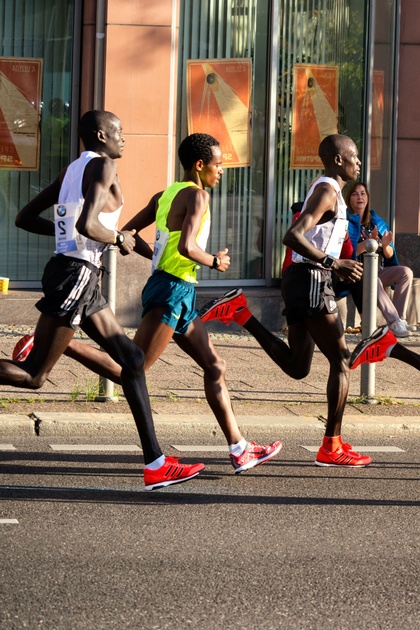
The domino effect with running
Foto: iStock.com/wayra
The domino effect makes you fast and enables you to make optimum use of the laws of physics. Only those who have perfectly mastered a forward-leaning posture can harness their full potential. Here you’ll learn how it works.
This article is brought to you by Medical Running
One key element is maintaining your spine in an upright and well-aligned position. This is vital, because the human body is designed to move efficiently, economically, and with agility while subjected the Earth’s gravitational pull.
The basic requirement for walking and running is maintaining an upright posture – with your whole body upright and aligned almost vertically, from the sole of your feet to the topmost point of your head. When running, there is another factor: tilting your body towards the front. A slight forward tilt provides extra propulsion. If your body is tilted forwards while standing, you will tend to fall forwards. If this tendency is great enough, you will be forced to get your legs moving and will thus rush forwards.
With professional runners, you can observe how they run slightly tilted forwards. The slight tendency to fall propels them forwards – step by step – to the finish line.
Getting a feel for the optimum forward tilt takes practice. Your head, shoulder, hip joint, and foot should be in a vertical line while standing. While running, these reference points should be tilted slightly forwards. How tense your body is plays an important role here. Your torso, in particular, must be strong enough to keep the forward tilt stable. The forward tilt of your body’s axis should be between 3 and 5 degrees, depending on your speed. That’s not much, but less is more here. An excessive forward tilt will make you collapse forwards and really impact your feet, meaning your legs are subjected to greater compressive force, you need more energy to brake, and your posture is doing more harm than good.
There is also a second type of excess forward tilt, when your hip is inclined too far forwards. Then your upper body and legs are no longer in a line, and there is a real bend between your legs and upper body. The excessive forward bend of your upper body has to be compensated further up, and your back and neck muscles have to do additional work. With your upper body tilted forwards, the muscles around your spinal cord are under constant tension.
But the opposite also can occur: while some run bent over like a banana, extremely posture-conscious runners overdo it in the other direction, with their necks overstretched, looking up at the sky, and their chest proudly stretched forward. Their entire spine then resembles an overly taught, overstretched bow.
Your body’s tilt angle and tension decide whether you succeed or fail here. Once you have managed to retain the correct tilt in your posture memory, you can put it to practical use while jogging.
Foto: iStock.com
This may be of interest for you too


